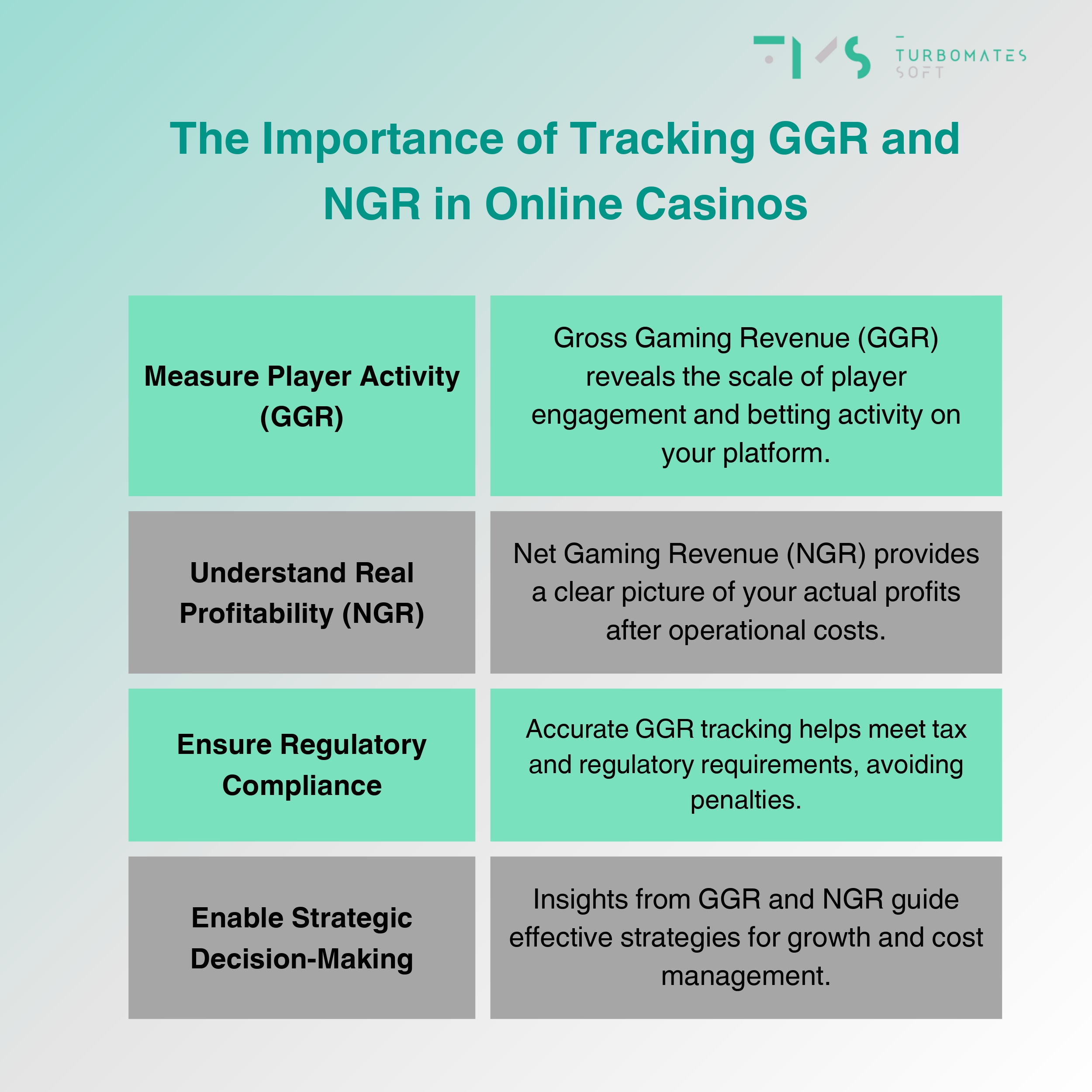Understanding GGR and NGR: Key Metrics for Casino Success
Running an online casino is much like navigating a dynamic and evolving maze. While players focus on the thrill of games and promotions, operators need to manage the intricate financial framework that keeps the business thriving. At the core of this framework are two vital metrics: Gross Gaming Revenue (GGR) and Net Gaming Revenue (NGR).
These metrics are more than just financial figures—they are the heartbeat of a casino’s operational success. They tell the story of how money flows through the platform, highlighting what is earned and, more importantly, what is retained as profit. But how do these metrics work, and why are they essential for operators to understand?
Let’s explore the world of GGR and NGR, uncovering their significance, differences, and strategies to optimize them for long-term profitability.
The Importance of GGR and NGR in Casino Financial Management
Imagine your online casino during peak hours: players spinning slots, joining poker tournaments, and placing bets on live sports. This activity generates a significant volume of wagers, which can look impressive on paper. However, there’s a critical distinction between revenue and profit.
Gross Gaming Revenue (GGR) is the headline number, representing the total amount wagered by players minus their winnings. It’s a measure of your casino’s scale and activity but doesn’t reflect profitability. That’s where Net Gaming Revenue (NGR) steps in. NGR subtracts operational expenses—such as bonuses, taxes, and payment fees—from GGR, revealing the true profitability of your business.
In essence, GGR gives you the big picture, while NGR provides the finer details. Together, these metrics offer a comprehensive view of your casino’s financial health, helping operators make informed decisions and refine their strategies.

GGR: Understanding and Calculating Gross Gaming Revenue
Think of GGR as the starting point for understanding your casino’s financial performance. It reflects the total revenue generated before any deductions and is often used to measure player activity and engagement.
How Is GGR Calculated?
The formula for GGR is straightforward:
GGR = Total Wagers – Total Winnings Paid to Players
Example
Let’s say players wager a total of $10 million on your platform in a month, and the casino pays out $8 million in winnings. The GGR for that month would be:
$10,000,000 – $8,000,000 = $2,000,000
Why GGR Is Important
GGR is often the first metric operators examine because it reflects the scale of the casino’s revenue-generating activities. A high GGR may indicate effective marketing campaigns, a well-optimized game portfolio, or strong player engagement.
In many jurisdictions, GGR is also the basis for calculating gaming taxes, making it a critical metric for regulatory compliance. However, while GGR provides insights into revenue potential, it doesn’t reveal how much of that revenue is actually retained as profit.
Boost your casino’s success with the right features!
Discover the Top 9 Must-Have Features of Online Casinos in 2024 to stay ahead in the competitive iGaming industry.
NGR: The Profitability Metric
If GGR is the big picture, Net Gaming Revenue (NGR) zooms in to show what’s left after covering operational expenses. NGR provides a more accurate reflection of your casino’s financial health, helping operators identify inefficiencies and areas for improvement.
How Is NGR Calculated?
The formula for NGR is:
NGR = GGR – Bonuses – Payment Fees – Affiliate Commissions – Taxes – Licensing Costs
Example
Using the previous GGR of $2,000,000, let’s consider the following monthly expenses:
- Bonuses and Promotions: $400,000
- Affiliate Commissions: $100,000
- Payment Processing Fees: $50,000
- Taxes: $300,000
- Licensing Costs: $50,000
NGR would be calculated as follows:
$2,000,000 – ($400,000 + $100,000 + $50,000 + $300,000 + $50,000) = $1,100,000
This $1,100,000 represents your actual profitability after accounting for operational costs.
Why NGR Matters
While GGR provides a snapshot of revenue, NGR tells the full story. It reflects the efficiency of your operations, indicating how well you’re managing costs and retaining profit. Investors and stakeholders often prioritize NGR because it provides a clearer picture of the business’s financial viability.
| Aspect | Gross Gaming Revenue (GGR) | Net Gaming Revenue (NGR) |
|---|---|---|
| Definition | Total wagers made by players minus winnings paid out. | GGR minus bonuses, taxes, commissions, and other operational costs. |
| Calculation Formula | GGR = Total Wagers – Winnings Paid | NGR = GGR – Bonuses – Taxes – Payment Fees – Licensing Costs |
| Purpose | Measures the scale of revenue generated by player activity. | Reflects actual profitability after deducting expenses. |
| Use Case | Commonly used for tax calculations and reporting to regulators. | Used internally to evaluate operational efficiency and profit margins. |
| Stakeholders | Relevant for regulators, tax authorities, and external audits. | Crucial for investors, stakeholders, and management decisions. |
| Focus | Emphasizes gross revenue potential. | Focuses on retained revenue and business profitability. |
How GGR and NGR Interact: A Balancing Act
Understanding the relationship between GGR and NGR is essential for crafting effective strategies. While GGR can indicate growth and activity, an imbalance between GGR and NGR might signal underlying inefficiencies.
The Role of Bonuses
Bonuses are a double-edged sword. On one hand, they drive player acquisition and engagement, boosting GGR. On the other hand, overly generous bonuses can erode NGR, especially if they’re exploited by players.
For example, a 100% deposit match might encourage significant wagering activity, increasing GGR. However, if the payout structure or bonus terms are too lenient, the additional costs could drastically reduce NGR.
Game Portfolio Optimization
Different games contribute differently to GGR and NGR. Slot games, for example, may generate high GGR due to their popularity and fast-paced nature but come with higher promotional and payout costs. Table games like blackjack or poker may generate lower GGR but often have better margins, positively impacting NGR.
Cost Control Strategies
Managing costs is key to maintaining a healthy NGR. Regularly reviewing expenses such as payment gateway fees and affiliate commissions can uncover opportunities for optimization. For instance, renegotiating rates with service providers or streamlining payment options can significantly reduce overheads.
Challenges in Managing GGR and NGR
Running an online casino isn’t without its challenges, especially when balancing GGR and NGR.
- Rising Operational Costs
As your casino grows, so do your expenses. Payment processing fees, affiliate payouts, and licensing costs can quickly add up, eating into NGR. - Bonus Abuse
Bonuses and promotions are critical for player acquisition, but they can be exploited. For example, players might create multiple accounts to take advantage of deposit bonuses, inflating GGR while hurting NGR. - Regulatory Complexity
Different jurisdictions have varying rules for taxing and reporting GGR and NGR. Staying compliant requires meticulous record-keeping and a thorough understanding of local regulations. - Market Competition
In a saturated market, operators often invest heavily in marketing and promotions to stand out. While these efforts can boost GGR, they may also lead to increased costs, impacting NGR.
Strategies to Optimize GGR and NGR
- Fine-Tune Your Bonus Programs
Analyze the effectiveness of your bonuses and promotions. Ensure they are enticing enough to attract players but structured to avoid abuse. Implementing wagering requirements or caps on winnings can help mitigate excessive costs. - Diversify Your Game Portfolio
Offer a balanced mix of games that cater to different player preferences. Popular games like slots can drive GGR, while table games and live dealer options can provide steady contributions to NGR. - Optimize Payment Processes
Work with multiple payment providers to negotiate lower transaction fees. Streamlining the payment process can also improve the player experience, boosting engagement. - Focus on Retention
Retaining players is often more cost-effective than acquiring new ones. Implement loyalty programs, personalized offers, and regular engagement campaigns to keep players active on your platform.
Partnering with Turbomates Soft for Success
Mastering the balance between GGR and NGR can feel overwhelming, but you don’t have to do it alone. At Turbomates Soft, we bring deep expertise in the iGaming industry to empower operators with innovative tools and strategies. Our goal is to simplify complex financial metrics and turn them into actionable insights that drive profitability and sustainable growth. Whether you’re just starting or looking to optimize an established platform, our customized solutions are designed to meet your unique needs and challenges.
Our Expertise
- Real-Time Analytics: Track GGR, NGR, and other KPIs in real time to make informed decisions.
- Cost Management Solutions: Identify inefficiencies and optimize expenses to maximize profitability.
- Custom Casino Platforms: Build scalable, feature-rich platforms that support your business goals.
- Compliance Assistance: Navigate regulatory landscapes with confidence and ensure full compliance.
Unlock Your Casino’s Potential with GGR and NGR Mastery
GGR and NGR are more than just financial terms—they are the keys to unlocking your casino’s potential. By understanding how these metrics interact and influence your bottom line, operators can craft smarter strategies, control costs, and drive profitability.
Whether it’s optimizing bonuses, diversifying your game portfolio, or negotiating better rates with service providers, mastering GGR and NGR is essential for building a sustainable business.
At Turbomates Soft, we specialize in helping online casinos achieve their financial goals. Let us guide you in optimizing your platform, enhancing profitability, and staying ahead in a competitive market.
Ready to take your casino to the next level? Contact us today to learn how we can help.
